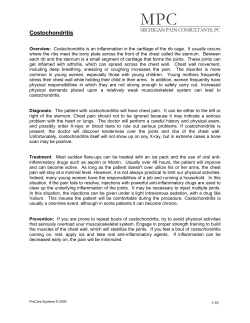
Fibrinolysis Treatment for Loculated Parapneumonic Pleural Effusion Secondary to
Proc. West. Pharmacol. Soc. 52: 11-13 (2009) CASE REPORT Fibrinolysis Treatment for Loculated Parapneumonic Pleural Effusion Secondary to Right Lower Lobe Pneumonia Lourdes G. Merlo, Saba Ansari, Bhupinder Singh, Fikerte F. Teferedgin, Kelly L. Cervellione Jonas Gintautas and Mohammad A. Babury Department of Clinical Research, Jamaica Hospital Medical Center, 8900 Van Wyck Expressway, Jamaica, NY 11418 *Email: jgintautas@jhmc.org Abstract The administration of fibrinolytic agents in the pleural cavity is an alternative treatment for the management of loculated empyemas in patients who are poor candidates for surgery and/or do not respond to more standard treatments (e.g., chest tube placement, pleurodesis). Unfortunately, in practice it is not frequently offered as an alternative treatment approach. Here we present the case of a 79-year-old male with right lower lobe pneumonia complicated by a parapneumonic pleural effusion that showed minimal improvement after chest tube placement and broad-spectrum antibiotic treatment. Intrapleural tissue plasminogen activator (tPA) was administered daily for three consecutive days, which resulted in the breakdown of intrapleural loculations and facilitation of drainage, followed by significant clinical and radiologic improvement. tPA was successful in the treatment of parapneumonic pleural effusions in a patient who was not a candidate for surgical intervention and who failed to respond to standard treatments. Introduction In most patients with symptomatic pleural effusion secondary to the progression of empyemas, the insertion of a chest tube is the first step in disease management. However, some patients experience an evolution of illness from the exudative stage (i.e. freeflowing pleural fluid) to an organized stage, characterized by fibrin strands bridging the pleural membrane. This causes development of a loculated pleural effusion that rarely responds to chest tube placement. In addition, in many cases, these patients are poor candidates for surgical treatment like thoracoscopic debridements or open thoracotomy, leaving palliative care as the best option for care. Intrapleural fibrinolytic (IPF) agents, however, can be used in these patients to break down the fibrin strands of intrapleuritic collection while circumventing the need for surgical drainage. In a recent article by the American College of Chest Physicians, it was concluded that fibrinolytic therapy and surgical drainage techniques represent competing options, but that appropriate patient selection and the relative timing of the procedures remain uncertain [1]. In the case we present, a 79-year-old male who was a poor surgical candidate was successfully treated for parapneumonic pleural effusion with intrapleural tissue plasminogen activator (tPA) after more standard treatments failed. This case illustrates the important role that tPA can have in the treatment of this and similar conditions. Case Report A 79-year-old black male presented to the emergency department with one week of progressive shortness of breath with associated left pleuritic chest pain and lowgrade fever. No dizziness, palpitation, perspiration, cough, peripheral edema, nausea or vomiting were present. He had moved to New York from the West Indies five years earlier. Past medical history included hypertension, chronic heart failure (EF: 15 %), chronic atrial fibrillation, chronic renal failure, chronic anemia, osteoarthritis and seizures. He was noncompliant with medications, including anticoagulants. He reported no surgical history and an unknown family history. During the initial evaluation, the patient was alert and oriented, hemodynamically stable and had no labored breathing. Electrocardiogram showed atrial fibrillation with rapid ventricular response. Chest x-ray (CXR) revealed cardiomegaly; the mediastinum was unremarkable, lungs were clear, and osseous structure was intact. After nitroglycerin patch placement, metoprolol (50 mg PO) and diltiazen (25 mg IV) were administered. Blood pressure dropped from 130/82 to 80/65 mmHg. The patient became poorly responsive, hypoxemic (02 Sat 88% in non-rebreathalble mask) and was intubated. Ventilation/perfusion scan had borderline suspicion for pulmonary embolism. Anticoagulation was initiated. During first week of admission, the patient was diagnosed with non-ST elevation myocardial infarction. All blood and urine cultures were negative. The patient Proc. West. Pharmacol. Soc. 52: 11-13 (2009) remained on ventilator. CXR showed a new, small, right infrahilar infiltrate. He was started on moxifloxacin. On day 9, the patient was extubated. Over the following two weeks, the patient had persistent, productive cough with yellowish sputum. There was progressive dispnea and persistently elevated white cell counts. Blood cultures remained negative. CXR showed large, loculated right pleural effusion in the right hemithorax. Pleural tap confirmed empyema and a chest tube was placed. A course of broad-spectrum antibiotics was begun. In the following days, there was minimal drainage and there was no improvement on CXR’s (Fig 1). The patient experienced respiratory failure, hypotension, and worsening renal failure. Endotracheal intubation, vasopressor support, and hemodialysis were required. Video-assisted thoracoscopic surgery (VATS) with decortications was ruled out as a treatment option due to the multiple co-morbid conditions and high risk for mortality. improvement was detected in the following 3-5 days with evident improvement in chest tube drainage (Fig. 2). The patient was successfully intubated. He remained stable, afebrile, and had spontaneous ventilation. He was subsequently discharged with no adverse events related to this hospitalization over the next 3 months. He had no reoccurrence of loculated parapneumonic pleural effusion. Figure 2. CT scan pre- (left) and post- (right) tPA administration shows significant improvement. Figure 1. Chest x-ray pre- (left) and post- (right) chest tube placement shows minimal drainage. Due to the limited treatment options, IPT was started with tPA 10 mg in 50ml NS via right chest tube daily for three days. The chest tube was clamped after each daily dose of tPA and was unclamped every 12 hours to inspect drainage. The patient’s position was changed every 2 hours. A markedly clinical and radiological Discussion It is well known that there are high morbidity and mortality rates related to the development of empyema and complicated parapneumonic effusion, with an estimated case-fatality rate of 15% [2]. Since the mid1900’s, IPFT has been known and accepted as a therapeutic option for the management of complicated parapneumonic effusion secondary to pneumonia, clotted hemothorax, or malignancy. Since unpurified fibrinolytic agents were initially used, significant systemic side effects were observed, thus lessening its attractiveness as a treatment option. Three decades later, the development of a purified form of Proc. West. Pharmacol. Soc. 52: 11-13 (2009) streptokinase improved effectiveness, consequently increasing its use as a therapeutic alternative for the management of complicated parapneumonic effusions. Since then, numerous studies have demonstrated the safety and effectiveness with the use of IPFT [3]. instillation, improving clinical status by favoring the apposition of the pleural surfaces and the expansion of lung parenchyma. The majority of these patients go later for pleurodesis with satisfactory resolution of the disease. Open thoracotomy and VATS are effective procedures in the management of complicated loculated parapneumonic effusions. VATS initiates a breakdown of adhesions, making drainage of the collection possible. It has an efficacy rate greater than 80% (4). Though VATS is a preferred treatment option, it carries a high risk of significant morbidity secondary to complications (e.g. prolonged air leak, gas embolism, dysrhythmia, respiratory failure, bleeding, infection, and lung perforation). It is absolutely contraindicated in patients with severe bullous lung disease or pulmonary hypertension. In addition, it is not always available in health centers and is very costly [4]. IPFT with streptokinase, urokinase, and t-PA is a widely-available and effective alternative to surgical management [5]. Some complications associated with intrapleural fibrinolisis are allergic reactions, bronchopleural fistula and pleural hemorrhage (more frequently seen with the use of streptokinase). Urokinase is a safer option than streptokinase, however, since it is made from human cells, there is an unpredictable risk for the development of infections after its use [6]. t-PA is made using recombinant DNA technology; side effects like allergic reactions and infections are thus less likely. Though the technique of administration of IPT is not yet standardized and there is a considerable lack of experience of its use for this type of indication, risks and benefits must be weighed on a case by case basis [3]. Based on our positive experience of successful treatment of IPF with tPA, we recommend considering IPF therapy in patients with complicated parapneumonic effusion secondary to pneumonia who respond poorly to antibiotic therapy and chest tube placement, especially in patients for which surgical management is not an option or is not available. IPFT is widely available and may be an effective therapeutic option in patients where the benefits overweigh the risks [8]. More extensive training of the use of IPT for situations such as that described here will improve patient care by widening the range of potential treatment options. Progression of empyema is characterized by the development of fibrinous adhesions (fibrothorax) and loculations, which makes drainage very difficult and in many cases even impossible to achieve. A second chest tube may not a good alternative when the initial tube thoracostomy is insufficient. IPFT clearly increases the rate of drainage after intrapleuritic treatment References 1. Colice G.L., Curtis A., Deslauriers J., Heffner, J., Light R., Littenberg B., Sahn S., Weinstein R.A., and Yusen R.D.. (2000) Chest . 118, 1158-1171. 2. Davies C.W., Kearney S.E., Gleeson F.V., and Davies R.J. (1999) Am. J. Respir. Crit. Care. Med. 160,1682-1687. 3. Banga A., Khilnani G.C., Sharma S.K., Dey A.B., Wig N., and Banga N. (2004) BMC. Infect. Dis. 4,19. 4. Weissberg D. and Schachner A. (2000) Ann. Ital. Chir. 71,539-543. 5. Tokuda Y., Matsushima D., Stein G.H., and Miyagi S. (2006) Chest 129,783-790. 6. Gervais D.A., Levis D.A., Hahn P.F., Uppot R.N., Arellano R.S., and Mueller P.R. (2008) Radiology 246,956-963. 7. Diacon A.H., Theron J., Schuurmans M.M., Van de Wal B.W., and Bollinger C.T. (2004) Am. J. Respir. Crit. Care. Med. 170,49-53. 8. Maskell N.A., Davies C.W., Nunn A.J., Hedley E.L., Gleeson F.V., Miller R., Gabe R., Rees G.L., Peto T.E., Woodhead M.A., Lane D.J., Darbyshire J.H., and Davies R.J. (2005). N. Engl. J. Med. 352, 865-874.
© Copyright 2025





















